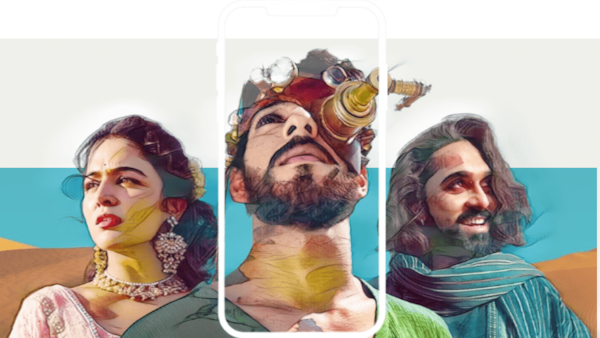Phoning It In: With Fursat, Vishal Bhardwaj Calls For A Different Frame
Bhardwaj is the latest leading auteur, after Steven Soderbergh and Park Chan-wook, to espouse the benefits of shooting a film with a smartphone (in this case, the iPhone), writes Manik Sharma.

Last Updated: 06.07 PM, Feb 12, 2023
IN A 2018 INTERVIEW, Steven Soderbergh proclaimed that the next big revolution in filmmaking would be the cellphone. “I look at this as potentially one of the most liberating experiences that I’ve ever had as a filmmaker,” he said about shooting an entire film on an iPhone. Things haven’t exactly transpired as Soderbergh prophesied, since the nucleus of filmmaking has been absorbed by mammoth techno-conglomerates like Marvel, DC and whatever James Cameron does next. Studio filmmaking commands markets where scale precedes conventional markers of substance. Apple has consistently attempted to market the possibilities of using a cellphone as a filming device, and with Vishal Bhardwaj’s short film Fursat it tempts once again, and reveals.
Fursat is a garden blast of colour, imagery and wild cinematography. There is a clear inclination to highlight — through whacky textures and hues — boundaries, but to also find the dynamism of cinema within it. Ishan Khatter and Wamiqa Gabbi star as two lovelorn youngsters. As is the case with most Bhardwaj films, music is central to both the conceit and the joy of his work. Khatter plays Nishant, a dreamer trying to fashion a device that will help him look into the future. Gabbi plays Diya, a grounded young doctor who wishes her lover would open his eyes to accommodate reality before it turns into a speculative nightmare for both. A bizarre hijacking aboard a train in the middle of desert helps the two come together. It’s also what helps Nishant realise that the ‘present’ is all he needs a view of.
It’s a neat philosophical idea, somewhat cramped by the creative brief to manufacture movement and colour where maybe neither were required. Khatter is unconvincing as the character but exhilarating as the balletic lead anchoring a life-sized dial in the song ‘Waqt Waqt’. There is plenty to like here, especially the pacey sequences, the rich cinematography and the desire to fit a whole gamut of variations within a single short film — song, dance, dream sequences, street chases etc. Unfortunately, the film fails to justify the medium through the traditional strengths of filmmaking — writing and acting. The clear winner here is the device as a fascinating device for capture, that appears to add character through its rawness. It explains why certain auteurs still believe in the cellphone’s future as disruptor.
Soderbergh has now filmed two full feature length films on the iPhone. His last, High Flying Bird (2019), was a chatty film set in the corridors of American basketball. His first, Unsane (2018), explored psychosis and horror. In 2012, Searching for Sugar Man, a film shot on a phone mimicking an 8mm print, took home the Oscar for Best Documentary. Sean Baker’s Tangerine (2015) is possibly the most popular film to be shot on a cellphone; a story of two prostitutes who bicker and bemoan the specifics of their lives, the film should have ideally led to the kind of breakthrough that Soderbergh continues to espouse that cellphones will eventually usher in.
There is good reason to trust the device’s disruptive capacity. For one it liberates filmmakers from having to marry cost to storytelling. Second, it quite simply squeezes the filmmaking process to its bare essentials. Soderbergh completed Unsane in two weeks. Filmmakers have over the years argued that the most painful part of the filmmaking process is the struggle to pool money for the kind of vision they believe in. It’s a problem that the cellphone somewhat solves, by returning agency to the maker. All you need is your collaborators, your actors and the story you wish to tell. A story that, mind you, still has to qualify for substance, unerringly radiating that emotional quality we so casually refer to as ‘cinematic’ without ever knowing what it really means. It’s something Fursat handsomely yet erringly exposes itself to. No amount of visual jugglery, alas, can rescue mediocre, ungainly material.
Only a year ago, Park-Chan Wook produced a similar film for Apple. As a 20-minute whimsical exploration of a folktale, the film works as a quirky comment on the nature of coexistence. Both these films, however, are attempts to outshine the perceived restriction of a stunted filmmaking toolbox. For inspiration on how to use the phone for cinema, we may be still need to look elsewhere, where the boundary isn’t the point. That is precisely where the lines between cinema, online, social and content begin to break. What is what? And yet nothing has to really change about your cinematic vision as Sean Baker, the director of Tangerine, has proven ever since by making films that still look and feel as untidy and chaotic as a reflection of life. Maybe that is what the cellphone is supposed to do. Help cinema accept life’s uncontrollable nervous system, beyond which, everything is just sophisticated flattery.
